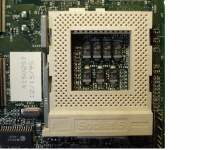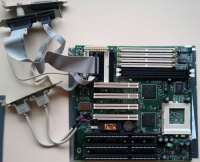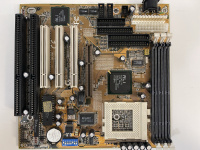Socket 5 / 7 / Super-7 Motherboards
Contents
Socket 5
Socket 5 was developed for the Pentium "P54C" CPU that operated at 3.3v instead of the original P5's 5.0v. This was a die shrink revision of the Pentium and operated at 75-120MHz with a bus speed of 50MHz, 60MHz or 66MHz.
There are several CPUs from companies other than Intel available for Socket 5. The Centaur/IDT Winchip and the AMD K5 are perhaps most well known. There are also several Intel Pentium Overdrive CPUs that were produced to match Socket 5 options to later Socket 7 CPU clock speeds.
Socket 5 motherboards are built to the AT specification, and typically use PCI and ISA slots. Some with OPTi chipsets have VLB slots as well, and some have onboard audio or video.
Chipsets
Intel
- 430NX "Neptune" - SMP, PCI 2.0, FPM DRAM, Asynchronous cache. 512 MB cacheable RAM limit. 512 MB max RAM. Some boards use IDE controller chips with known bugs, like CMD640.
- 430FX "Triton" - 16 MB/s DMA IDE, PCI 2.0, FPM/EDO DRAM, and pipeline burst synchronous cache options. 64 MB cacheable RAM limit. 128 MB max RAM.
OPTi
- OPTi Viper
SiS
- SiS 501/502/503 - PCI, ISA, FPM/EDO DRAM
- SiS 5501/5502/5503 - ISA, PCI, FPM/EDO DRAM
UMC
- UM8891 - PCI, ISA, FPM(/EDO?) DRAM, Asynchronous cache. Memory controller is 32b wide (486-vintage), severely hampering performance.
Socket 7
Socket 7 brings optional "split-rail" voltage support, which is required for CPUs that use a core voltage different than 3.3v IO. Initially the socket was used with "P54C" Pentium CPUs that went to 200 MHz (motherboards from this period typically do not support split rail CPUs), and later the Pentium MMX "P55C" that went to 233 MHz. Socket 7 boards typically support 60 and 66 MHz bus speeds, but many motherboards allow a wider range to support some non-Intel CPUs. Alternative CPUs include products from Cyrix/IBM, AMD, Rise and IDT/Centaur.
Socket 7 motherboards are available in AT and ATX form factor. They have PCI and ISA slots. Some have extra onboard components like audio and video.
Chipsets
Intel
- 430HX "Triton II" - 16 MB/s BM-DMA IDE, SMP, PCI 2.1, USB 1.0, FPM/EDO DRAM and pipeline burst synchronous cache options. Supports either 64 MB or 512 MB cacheable RAM. 512 MB RAM max.
- 430VX "Triton II" - also unofficially known as "Triton III", 16 MB/s BM-DMA IDE, PCI 2.1, USB 1.0, FPM/EDO DRAM, 2clk SDRAM and pipeline burst synchronous cache options. 64 MB cacheable limit. 128 MB max RAM. Slightly slower than 430HX.
- 430TX - 33 MB/s UDMA IDE, PCI 2.1, USB 1.0, ACPI, FPM/EDO DRAM, 2clk SDRAM, and pipeline burst synchronous cache options. 64 MB cacheable limit. 256 MB max RAM (official) / 512MB (unofficial, with 16Mx8 chips on 2 double-sided DIMMs)
VIA
- VIA Apollo Master (570M) - FPM/EDO DRAM
- VIA Apollo VP-1 580VP (585VP/587/586A) - FPM/BEDO/EDO DRAM, SDRAM, max. 512 MB, 50/60/66 MHz FSB, USB 1.0, 16 MB/s DMA IDE
- VIA Apollo VPX/97 580VPX (585VPX/587/586B) - FPM/EDO DRAM, SDRAM, max. 512 Mb
- VIA Apollo VP-2 590VP (595/586A) - FPM/EDO DRAM, SDRAM, max. 512 Mb
- VIA Apollo VP2/97 590VP (595/586B) - bug fix?
- VIA Apollo VP3 597 - FPM/EDO DRAM, SDRAM, max. 1 Gb, AGP 1.0
SIS
- SiS 5511/5512/5513 - ISA, PCI 2.0, FPM/EDO DRAM, 16MB/s PIO4 IDE, 66MHz FSB support. Supports UMA (shared memory between CPU and VGA controller) with a separate optional SiS 620x VGA chip on the motherboard.
- SiS 5571 "Trinity" ISA, PCI 2.0, FPM/EDO DRAM, 16MB/s PIO4 IDE, 75MHz FSB support. Maximum cacheable RAM: 64MB. Maximum RAM: 384MB
- SiS 5581/5582 "Jessie" ISA, PCI 2.1, FPM/EDO/SDRAM, UDMA-33 IDE, 83MHz FSB support. Maximum cacheable RAM: 128MB. Maximum RAM: 384MB
- SiS 5591/5595 "David" ISA, PCI 2.1, AGP, FPM/EDO/SDRAM, UDMA-33 IDE, 95MHz FSB support. Maximum cacheable RAM: 256MB. Maximum RAM: 768MB
- SiS 5596/5513 "Genesis" ISA, PCI 2.0, FPM/EDO DRAM, 16MB/s PIO4 IDE, integrated SiS 620x PCI core via UMA, 75MHz FSB support. Maximum cacheable RAM: 64MB. Maximum RAM: 384MB
- SiS 5598/5597 "Jedi" - ISA, PCI 2.1, FPM/EDO/SDRAM, UDMA-33 IDE, integrated SiS 6326 PCI core via UMA, 75MHz FSB support. Maximum cacheable RAM: 128MB. Maximum RAM: 384MB
- SiS 530 + SiS 5595 - ISA, PCI 2.2, FPM/EDO/SDRAM, UDMA-66 IDE, integrated SiS 6326 AGP core via UMA, 100MHz FSB support. Maximum cacheable RAM: ?. Maximum RAM: 768MB
- SiS 540 - ISA, PCI 2.2, FPM/EDO/SDRAM, UDMA-66 IDE, integrated SiS 305 AGP core via UMA, 100MHz FSB support. Maximum cacheable RAM: ?. Maximum RAM: 768MB
ALI
- M1451/M1449
- M1521/M1523 / ALADDiN III -
- M1531/M1543 / ALADDiN IV -
- M1531B/M1543 / ALADDiN IV+ - FSB max. 83 MHz
- M1541/M1542 / ALADDiN V -
- M1561/M1535D / ALADDiN 7 - 66,100 MHz FSB, USB 1.0, UDMA2, SDRAM max. 1GB
OPTi
- OPTi 82C750 "Vendetta"
- OPTi "Viper Xpress+"
VLSI
- VLSI "Lynx" 541/543
ETEQ
ETEQ chipsets are Via chipset relabeled by motherboard manufacturer Soyo.
- Eteq 6618 relabeled Via VPX
- Eteq 6628 relabeled Via VP3
- Eteq 6638 relabeled Via MVP3
AMD
- AMD-640 (640/645) relabeled Via VP2
PCChips
- PCChips didn't produce any of their own chipsets, but relabled those from SiS, ALi etc.
Super Socket 7
Super Socket 7 is an AMD creation. They modernized the Socket 7 platform with AGP and 100 MHz bus support for their K6-2 processor. Intel was not involved with this nor did they produce CPUs specifically for it.
Chipsets were produced by ALI, VIA and SiS. The boards come in AT and ATX form factors and usually have AGP, PCI and ISA. Some boards use integrated graphics and forgo the AGP slot. Usually Super Socket 7 boards will come with sockets for SDRAM.
These solutions competed against Intel Celeron and Pentium II.
Today:Super Socket 7 (and to a lesser extend the ordinary Socket 7) is a very popular base for a retro computer build, not only for nostalgia reasons but also for it's great flexibility when it comes to CPUs. Basically any Socket 5 and Socket 7 CPU will be compatible with Super Socket 7. Not only was this the last (and fastest) platform available where both Intel CPUs (Pentium 1 MMX) and AMD CPUs (K5 and all K6 variants) were compatible with, but also some of the more obscure CPUs like Cyrix 6x86 and MII, Rise mP6 and the Winchip CPUs. Another big advantage is that usually CPUs for (Super) Socket 7 didn't have their multipliers unlocked, which adds even greater flexibility.
Many of the later Super 7 boards were made in ATX format instead of the older AT format which makes building a Super Socket 7 based retro rig a lot easier and as Socket 7, Super 7, Socket 370 and Socket A share the same CPU socket dimensions, many more modern CPU coolers are (in theory) compatible with Super 7 motherboards.
Super 7 has some disadvantages though, mostly because of it's relatively lacking performance compared to contemporary Slot 1 counterparts. Many Super 7 boards will have lots of motherboard components directly around the CPU socket, making installation of a larger CPU cooler more difficult. Super 7 can also be quite tricky to setup, partly due to the many jumpers required to correctly setup the installed CPU and partly due to some motherboards requiring a BIOS update before certain newer components may work correctly (particularly support for larger harddrives and the K6+ CPUs). Another disadvantage is it's relatively lacking AGP support, which makes adding more modern AGP cards more of a challenge, though this isn't as much of an issue compared to Slot 1 based systems due to it's relative lack of performance compared to CPUs like Pentium 3. The AGP issues is one of the reasons why 3DFX cards are often seen as a good match for a Super 7 system, partially because cards like Voodoo 3 use fewer AGP features, which also means there are fewer things that can go wrong.


